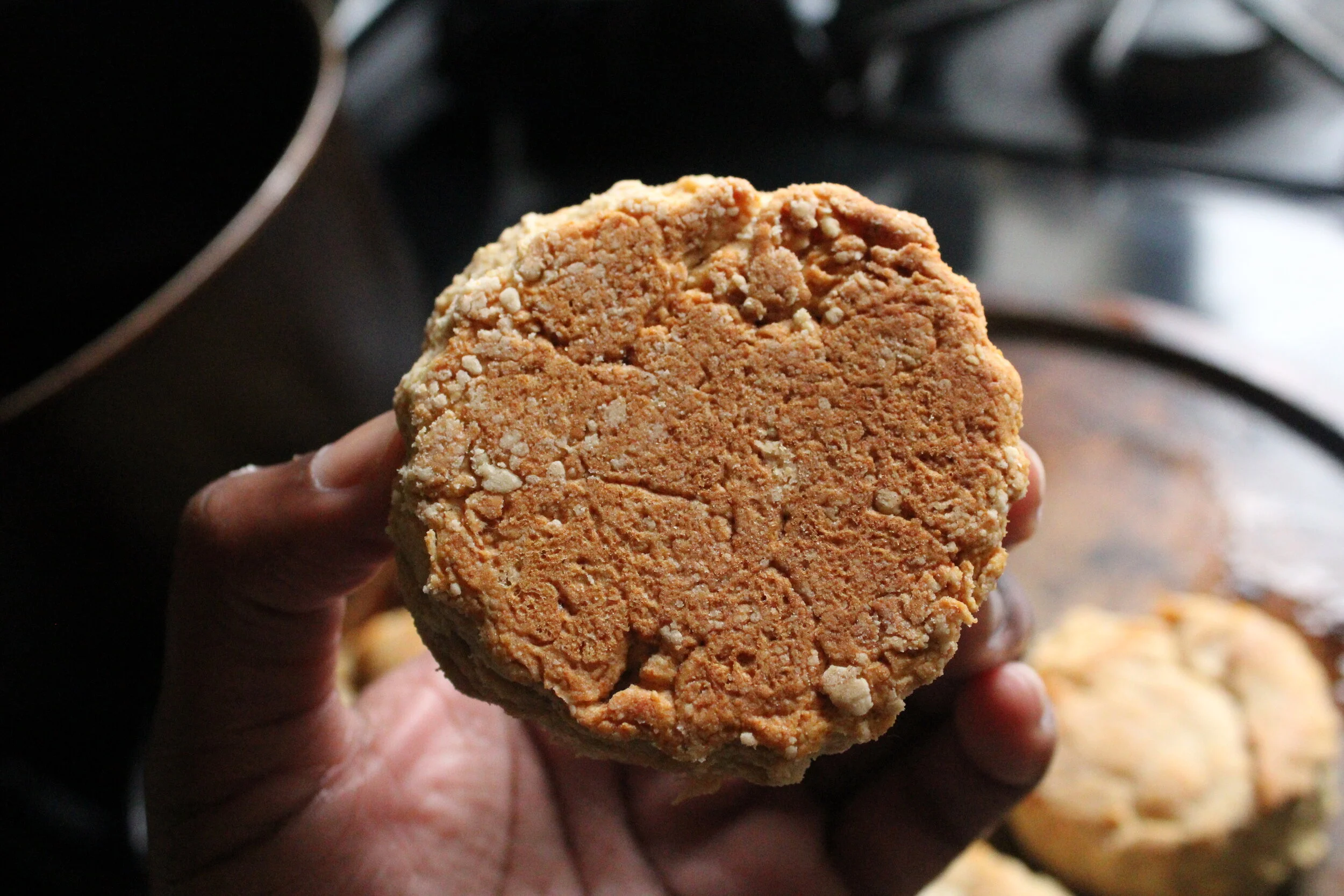Chapter 3. Biscuits

Right after cornbread, biscuits were probably one of the first breads I learned to make growing up. Was I as good at making them as I was cornbread? Definitely not. Were they as forgiving as dinner rolls? Heck no.
There used to be a running joke in our family that hard biscuits or scones were to be called stones. I made stones often, usually when I was rushing the process or upset about something.
Our family friend, who I’ll call Miss Lupine, made amazing biscuits and other short breads. I definitely looked forward to when she’d come over for our tea parties hoping she had brought one of her homemade breads or confections.
However, it wouldn’t be until I went to culinary school and started working that I’d get really good at making biscuits and scones. The place I mastered biscuit making was at this little cafe in the South Street Seaport district, where the head baker (an aspiring actress) taught me what to look for in making a consistent dough and how to make it quickly. Because if there was anything that was in high demand at that cafe it was biscuits, and I remember making so many batches every day, even in the summer heat.
The seating area where customers sat was obviously air conditioned, but the kitchen presented the typical NYC environment of being disproportionately small and hot. Biscuits don’t shape and bake well in such a space, so I had to get a rhythm down to keep the butter from melting completely. By the time I left that cafe for California I could have a batch of biscuits in the oven in about 10 minutes or so.
I can still make a batch of biscuits pretty quickly, but these days I try to slow down and actually enjoy the process especially since I’m not thee biggest fan of bread and am usually making it for friends. It’s also nice to not work with food at a pace where ingredients become a whir. Where you kind of stop seeing them as food and start seeing them just as objects that people happen to eat.
I like feeling the dough of clumping between my fingers as I incorporate the flour, and how soft it becomes when I start to knead it. And I still get excited when the biscuits come out of the oven higher than they were when they went in. These biscuits are definitely better than the ones I made as a kid and taste great with homemade jam or the base of an egg sandwich.
The Receipt - Featherlight Biscuits
Ingredients:
1½ cups Milk (dairy or non-dairy)
1 tbsp. Vinegar
3 cups Flour (plus some extra bench flour)
1 cup Whole Wheat Flour
1 ½ tbsp. Sugar
2 tbsp. Baking Powder
1 tsp. Salt
1 tsp. Baking Soda
1 ½ sticks Butter (dairy or non-dairy works), cut into ½” cubes
Directions:
Heat the oven to 350F (325F if using a convection oven). Lightly oil an 11x13” baking sheet. Set aside.
Combine soy milk and vinegar in a small bowl. Set aside.
Place flours, sugar, baking powder, salt, and baking soda in a medium bowl and mix together thoroughly. Then sift your ingredients into a large bowl.
Add cubes of butter to the flour mixture and use a fork (or pastry cutter or your fingers) to combine flour with butter. Your goal is to have pebbles of butter coated in flour, a granular flour/butter mixture, not a sandy flour/butter texture.
Add in milk mixture and combine with flour until you have a moist, sticky dough.
Place dough on a floured surface and knead 3 times, then shape into a ½” thick rectangle. Use a floured, round cutter (1½”-2” diameter) and cut out 12-8 biscuits. Place each dough round on a baking sheet and place in the oven for 25-30 minutes, or until biscuits are risen and lightly browned. Their bottoms should be a caramel brown color and lift easily from the pan.
Bonus Biscuit Content:
Inventor of Biscuit Cutters
Alexander P. Ashbourne by (blackpast.org)
Alexander P. Ashbourne-A Cut Above the Rest by Elizabeth Goldman on Medium
Alexander P. Ashbourne by J. Marley Todd
Inventor of Wheat Reaper
Virginia Slavery in Atlantic Context, 1550 to 1650 Chapter Four Author(s): PHILIP D. MORGAN Book Title: Virginia 1619 Book Subtitle: Slavery and Freedom in the Making of English America Book Editor(s): PAUL MUSSELWHITE, PETER C. MANCALL, JAMES HORN Published by: University of North Carolina Press. (2019) Chapter can be found HERE.


















